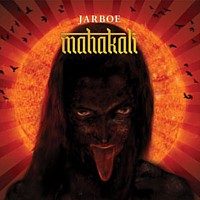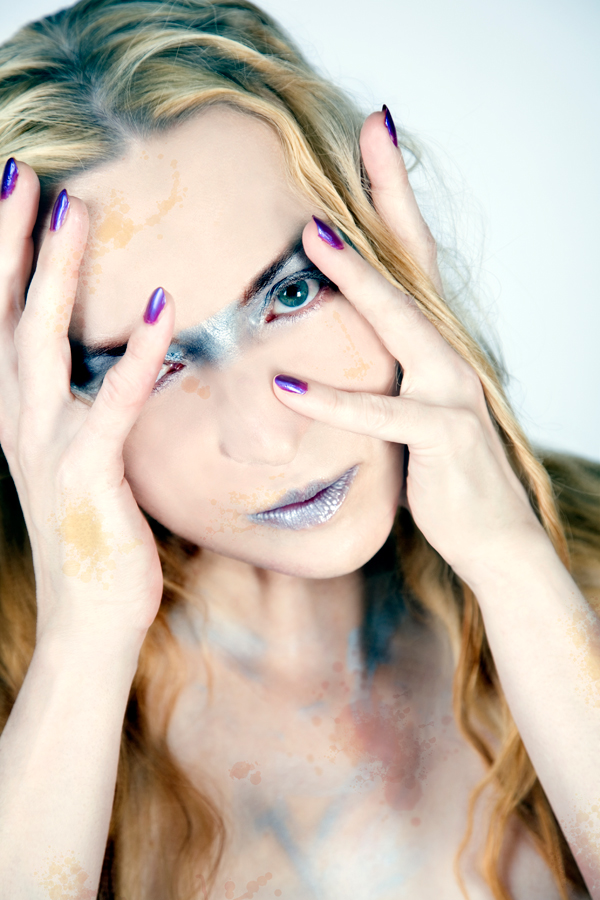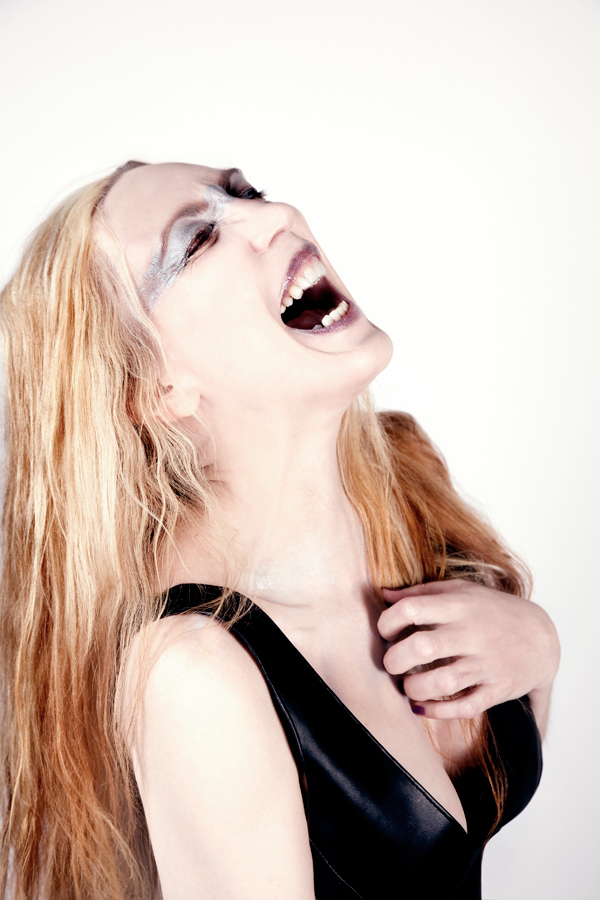 Jarboe: Mahakali (The End, 10/14/08)
Jarboe: Mahakali (The End, 10/14/08)
Jarboe: “The House Of Void”
[audio:https://alarm-magazine.com/wp-content/uploads/2010/03/Jarboe-The-House-Of-Void.mp3|titles=Jarboe: “The House Of Void”]It’s mid-August, and it’s cold in Denver. It’s been raining for something like 34 hours straight. I spent the bulk of that time locked in my condo, listening to Jarboe and her myriad projects, incarnations, and collaborations with buddies and underground metal all-stars such as Swans, Justin K. Broadrick of Jesu, and Neurosis.
My mood has been affected accordingly. The creaks in my house have taken on a menacing air; there’s intelligence in the light around me; I’m seeing colors; I’m remote-viewing back to weird, old-world landscapes; I just awoke from a dream about choking, and I’m deep in the throes of a particularly penetrating sweat. I need to get out of here. I think that my neighbors will be the largest beneficiaries of that move; my walls are thick, but they’re not Jarboe thick.

Following this kind of strangeness, it helps to think on some touchstones that are grounded in the commonality of it all. It’s 2008, and the Olympics are on; the Democratic National Convention will be rolling into town soon; war is not yet obsolete; mankind is still uncovering new ways to hate our differences with medieval aplomb; Jarboe is right back in the thick of a wicked, resurgent metal scene.
The avant-garde songstress says, with palpable excitement in her voice, that “throwing myself into the void, pushing myself hard, pushing myself to exhaustion — that’s what drives me. That’s why I like loud, aggressive music. That’s how I’m wired!”
She is a woman who seems hyperactively aware of those moment-to-moment changes that shape her consciousness, which extend past her art and music. She is straight-edge, practices extreme boxing, and her hands are callused from carrying her own equipment. She has refused to accept the role of novelty act in the very masculine world of metal.
“My artistic base is grounded in Swans. It’s how I was refined; it’s how I adjusted; it’s how I developed. It was such a big part of my life. I could never turn my back on that.”
But perhaps most telling are the actions that led her into the grips of the early ’80s New York no-wave scene. Upon hearing Michael Gira’s band, Swans, she set out for New York City with the sole intention of joining the band. Gira started her off on bass, but she was quickly recognized as an artistic force, and with vocal, keyboard, and songwriting contributions, she helped to shape the unique, heavy sound in one of that era’s most important underground metal acts.
Gira and Jarboe closed shop on Swans over a decade ago, but Jarboe remains lightning-eyed and howling. Her sounds are best not described from any clinical standpoint, as one could get lost in a string of descriptive words that don’t necessarily do justice to the tactility of her work (Old Testament-informed post-industrial dirge, a cross between yodeling and church-worship chorusing, etc.).
Jarboe’s works are temporal, as heavily influenced by current experience as they are informed by her Swans days. As such, it’s better to swoop in from above with general ideas about what she’s doing in the present that continues to drive her towards the extreme ends of multimedia art and music.

The physical representation of her sound is a good place to start; Jarboe has a history of intense cover art and intimidating album names. Her 2004 release, Anhedoniac, featured edgy, limited-edition, Wal-Mart-repellent nudes taken by Richard Kern. The most accessible of these depicts her naked and devoid of pigment, holed up in a cell and clawing at the bars on a window. As she explains, “It’s what I’ve done as a performance artist that led to my work with audio experimentations, feedback, and multi-track delays. It cracked me open to hear sounds in a different way; it shifted things to where I didn’t need a traditional melody.”
Her second release of 2008, Mahakali (following J2, a collaboration with Broadrick), continues in this vein, although the concept contributes heavily to the depth of the album. The cover is an animation-enhanced photo of Jarboe posing in a particularly threatening portrayal of the Hindu goddess Mahakali. Though traditional portraits show the goddess with a lolling tongue, Jarboe assured me that every muscle in her head contributed to the considerable tongue length in that shot, quipping through her faded Southern drawl that “it definitely gives you a greater appreciation for the talents of Gene Simmons.”
Mahakali herself lends a weighty contextual element to the sound of the album. The goddess is associated with the dichotomies of annihilation and creation, time and change. For Jarboe, this is an apt symbol for the state of the planet — politically, environmentally, and otherwise. It’s alternately a tragic concession of what needs to happen to move forward and a condemnation of those events that got us here. The goddess is often depicted as having many faces — a concept that flows volcanically through Jarboe’s work and life.
She uses the term “flexible reality” to describe the different phases, faces, and personas of her post-Swans act as The Living Jarboe. Sonically, she seems to toe the line of every diagnosable personality disorder as she weaves easily digested harmonies, Swans-esque industrial churn, a string section, and most notably, an arc of rangy vocals into her unique vision of black metal (“rangy” is perhaps not the word here, but I defy you to tell me what that word is).

Like some Wiccan version of Tom Waits, she uses her voice as an instrument that can be bent across the full spectrum of sound and style. The opening track on Mahakali, “Mahakali, of Terrifying Countenance,” has a techno-erotic paganism that bares no resemblance to the smoky sound that opens “The House of Void.” Somewhere in that track, her voice cuts sharply through the fog, only to become indistinguishable from what could be either a squealing guitar or her own manic shriek.
This awareness of her multifaceted personae is a condition that might explain her propensity to collaborate. As a serial collaborator, her sound tends to ricochet as it bumps up against the experiences of other artists. On Mahakali, Jarboe has recruited an impressive roster of talent to help shape the different faces of the album.
In a manner completely opposite of the across-the-ocean, file-sharing collaboration with Broadrick, she brought into the studio members of Dysrhythmia, Neurosis, Antony and the Johnsons (not Antony), Unsane, Amber Asylum, former Swans drummer Vinny Signorelli, Attila Csihar of Mayhem, and most strikingly, Phil Anselmo of Pantera.
She had the idea to insert Anselmo into an environment that is seemingly caustic to his black-metal personae. It works. His vocals on “Overthrown” are the howling, emotional core of the album. Anselmo’s voice here is as raw as red meat, but a cello is layered underneath, and a soulful harmony surfaces from beneath his otherwise tough sound. Backed by some aggressive acoustic bullying, the track is a rugged, Southern-gothic roar.
For all her faces, Jarboe remains existentially rooted in those days spent pioneering with Swans. In fact, Child of Swans was the working title for this new album. “The Swans were my education,” she says. “It altered the way I hear sound permanently. My artistic base is grounded in Swans. It’s how I was refined; it’s how I adjusted; it’s how I developed. It was such a big part of my life. I could never turn my back on that.”

